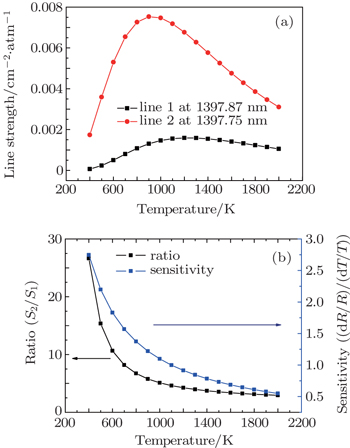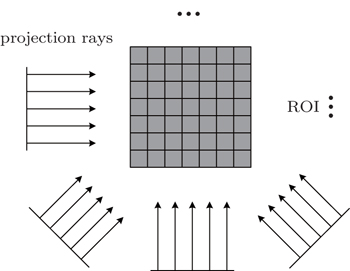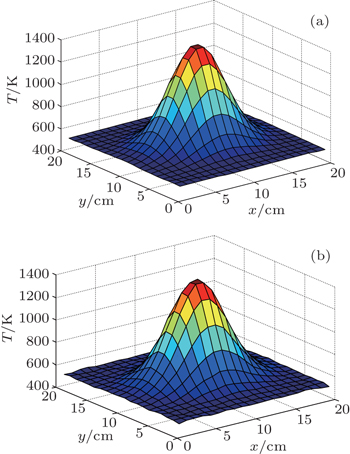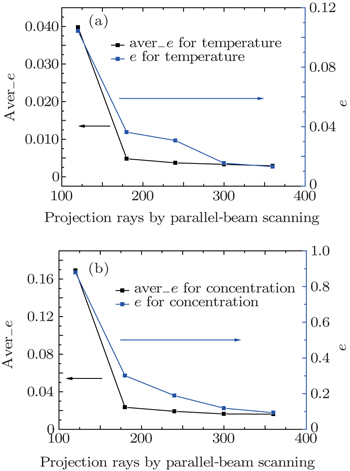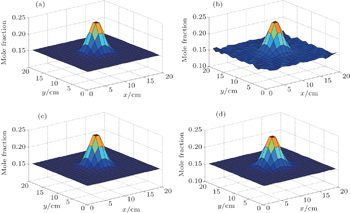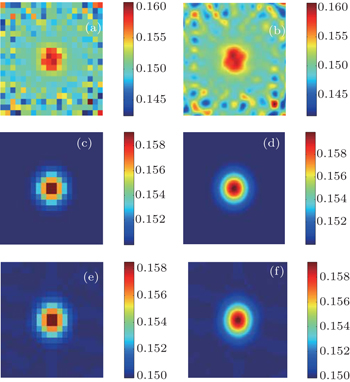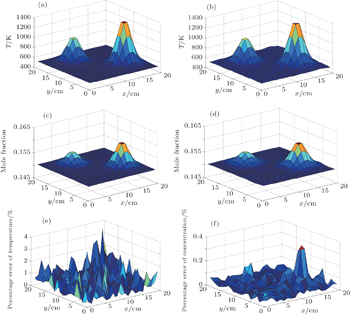† Corresponding author. E-mail:
Project supported by the Young Scientists Fund of the National Natural Science Foundation of China (Grant No. 61205151), the National Key Scientific Instrument and Equipment Development Project of China (Grant No. 2014YQ060537), and the National Basic Research Program, China (Grant No. 2013CB632803).
An improved algebraic reconstruction technique (ART) combined with tunable diode laser absorption spectroscopy(TDLAS) is presented in this paper for determining two-dimensional (2D) distribution of H2O concentration and temperature in a simulated combustion flame. This work aims to simulate the reconstruction of spectroscopic measurements by a multi-view parallel-beam scanning geometry and analyze the effects of projection rays on reconstruction accuracy. It finally proves that reconstruction quality dramatically increases with the number of projection rays increasing until more than 180 for 20 × 20 grid, and after that point, the number of projection rays has little influence on reconstruction accuracy. It is clear that the temperature reconstruction results are more accurate than the water vapor concentration obtained by the traditional concentration calculation method. In the present study an innovative way to reduce the error of concentration reconstruction and improve the reconstruction quality greatly is also proposed, and the capability of this new method is evaluated by using appropriate assessment parameters. By using this new approach, not only the concentration reconstruction accuracy is greatly improved, but also a suitable parallel-beam arrangement is put forward for high reconstruction accuracy and simplicity of experimental validation. Finally, a bimodal structure of the combustion region is assumed to demonstrate the robustness and universality of the proposed method. Numerical investigation indicates that the proposed TDLAS tomographic algorithm is capable of detecting accurate temperature and concentration profiles. This feasible formula for reconstruction research is expected to resolve several key issues in practical combustion devices.
Over the past decades, tunable diode laser absorption spectroscopy (TDLAS) has become an indispensable method of making sensitive and fast in-situ measurements in gaseous detection, such as species concentration, pressure, temperature, and velocity.[1–3] Traditional absorption spectroscopy is a line-of-sight (LOS) technique, which can only reflect the averaged value along the light path without providing any spatially resolved information,[4–6] while the temperature and concentration among the combustion area are usually non-uniform, thus, it is necessary to accurately obtain the spatial distributions of fluid field parameters. Recently, TDLAS data have been combined with computer tomography (CT), herein referred to as tunable diode laser absorption tomography (TDLAT), to image two-dimensional (2D) distribution of combustion properties of a scramjet wind tunnel. TDLAT can be roughly divided into two categories in terms of reconstruction algorithm: one is the transformation method, in which the representative algorithm is the filtered back projection (FBP) algorithm,[7,8] which needs complete projection data to realize physical reconstruction, and the other is the iterative method, in which the main example is algebraic reconstruction technique (ART) algorithm.[9–12] Bryner and Sharma employed the filtered back projection algorithm to reconstruct the peak of the water vapor absorption transition centered at approximately 7164.9 cm−1 of a flat burner and indoor environment based on experimental measurements.[13] Li et al. designed a set of TDLAT systems with six parallel rays which were arranged at different positions, they reconstructed the temperature and concentration distribution of a scramjet combustor exit using ART.[14] Ma et al. used a tunable laser called “fiber Fabry–Perot tunable filter laser (FFP-TFL)” to scan over the 1333 nm–1377 nm range at ∼ 200 Hz in the 2D reconstruction of temperature and H2O concentration distributions over a Hencken burner flame.[15] Although the FBP algorithm can obtain highly accurate reconstructions of the objective area, especially in medical imaging, a large number of closely sampled angular views and projection rays may increase the difficulty of experimental design, therefore, FBP reconstruction study based on laboratory verification is rarely reported in the literature. Unlike FBP, ART tomography algorithm has been successfully used for combustion diagnosis because of its strong resistance to noise and availability with only limited projection data.[12,16] Recently, a new method called multispectral absorption tomography (MAT), which greatly facilitates the practical implementation and application of the tomography technique, has been proposed to obtain simultaneous tomographic images of temperature and species concentration. Even though many researchers have done relevant work for imaging, it is hard to evaluate the accuracies of reconstruction results, especially the concentration distribution result, it is usually not so satisfactory when compared with temperature reconstruction by using a traditional method.[17]
In this paper, we divide the combustion area into 20 × 20 grids, and theoretically discuss the reconstructions of temperature and concentration with different projection rays based on a modified adaptive algebraic reconstruction technique (MAART).[18] More importantly, we propose a novel way to eliminate the concentration reconstruction error, which greatly improves the accuracies of the results when compared with the traditional method, furthermore, an optimal spatial structure of the test system including parallel-beam projection rays and grid partition principle is also suggested in this paper later. At the same time, asymmetric temperature and concentration distribution models are created to analyze the robustness and universality of the proposed algorithm. By means of this paper, the temperature and concentration can be simultaneously and accurately reconstructed whatever the combustion flow field is like in the future.
Generally the TDLAT can be divided into two parts: absorption spectrum theory and tomographic reconstruction algorithm.
According to the Beer–Lambert law, when collimated light at a certain frequency penetrates a gas medium of path length, L, the relationship between the transmitted and incident intensity of radiation is expressed as

The integrated absorbance of the transition i can be inferred from the above as



Prior to the study of the tomography algorithm, we divide the region of interest (ROI) into N (N equals n × n) grids, and the flame parameters such as pressure, temperature and gas concentration are assumed to be constant in each grid, then the integrated absorbance A of transition i in Eq. (


Here we use a modified adaptive algebraic reconstruction technique (MAART),[18] instead of the matrix theory, to compute α, and use this ART method to solve linear equation (





By using Eqs. (

H2O is an attractive target species for combustion diagnosis due to the relative abundance of water vapor as a combustion product and a strong near-infrared absorption spectrum. In this work, two transitions 7153.722 cm−1 & 7153.748 cm−1 and 7154.354 cm−1, have been selected to infer temperature by the two-line scheme because of their suitable line-strength and freedom of significant interference from nearby transitions,[9,17] these two overlapped transitions 7153.722 cm−1 and 7153.748 cm−1 can be treated as one transition when we deal with their line strengths, integrated absorbances, and center frequencies. The dependences of the two line strengths on temperature can be obtained from HITRAN 2008 or be calculated by Eq. (
In the simulation, we assume that the ROI is 20 cm×20 cm, then the ROI is divided into 20 × 20 grids, namely, the lengths for both X and Y axis directions of each grid are 1 cm, which is a relatively high spatial resolution to understand the information about combustion flow field. Parallel-beam possesses 20 light rays at each projection angle, and these rays rotate around the ROI for generating projection data in different views. This parallel laser-detector scanning geometry is shown in Fig.
A Gaussian model is designed for simulating the temperature and concentration distributions of the combustor exit of a flat flame furnace, and we can arbitrarily specify a possible distribution using this Gaussian function. In this paper a temperature range (500 K–1400 K) of interest is taken for example, similarly, water vapor concentration, i.e., volume fraction varies from 0.15 to 0.25 for testing, and the total static pressure is always 1 atm, which is the case for many practical applications. First of all, projection data of the numerical phantom, which is exactly equivalent to the integrated absorbance A,[24] can be obtained directly from Eq. (
As can be seen from Fig.


After scanning by the different parallel-beam projection rays, the temperature reconstruction error is plotted in Fig.
From the figure above we can obviously see some typical trend: the error decreases with the number of the projection data increasing, and the reconstruction accuracy is significantly dependent on the number of projection rays when it is less than 180, and after this point, it has little influence on e and aver−e, which indicates that there is no need to increase as many projection rays as possible in the TDLAT experiment. For 20 × 20 grid partition, in consideration of laboratory verification and experimental condition, the arrangement of about 180 projection rays is accurate enough to reconstruct the temperature distribution.
Just as described in most of the research, once the temperature of each grid is known, the line-strength S can be calculated, and then the local concentration is obtained from Eq. (

In terms of the water vapor concentration reconstruction involved in this paper, we analyze the results just like temperature mentioned in the above. The original and reconstructed concentration images are plotted respectively in Figs.
Figures
It turns out that the concentration can be easily reconstructed as long as the temperature has been imaged correctly. However, it is evident that the concentration reconstruction results are usually worse than the temperature reconstruction from either Fig.
Currently, a unique and standard way of solving the concentration distribution is through directly iterative calculation instead of indirect derivation by temperature reconstruction results. In practical measurements, with T in hand, the line strength S(T) for each grid can be figured out easily, then we define another projection weight L′, called normalized L, which is described by the multiplication of original weight L at each grid and the corresponding line-strength, and shown as follows:

Since the pressure of the combustion region remains 1 atm in our study, integrated absorbance A for every transition of a certain laser beam will be converted into Eq. (

According to the previous text, there are 2I absorption formulas because the total number of projection laser beams is I, now we combine all these 2I equations together as follows:
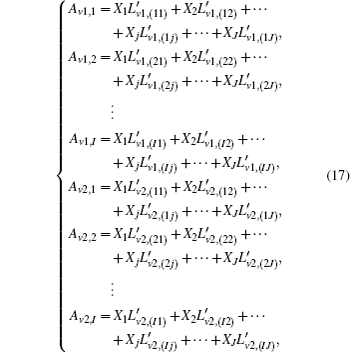


In order to reconstruct the concentration distribution by ART from Eq. (
In order to obtain a high spatial resolution image, cubic spline interpolation algorithm is used to realize a 200 × 200 grid distribution, which is displayed in Figs.
| Table 1. Error analyses for 300 parallel-beam scannings. . |
It can be seen that the tomographic accuracy of concentration reconstruction can be greatly improved by the proposed method. To further validate the modified concentration calculation algorithm, we employ this modified way to conduct the reconstruction whose ROI is the same as the distribution depicted in Fig.
In some complicated combustion environments, the very specific case of the centrosymmetrical Gaussian distributions of temperature and mole fraction discussed above should be expanded to include a range of possible cases. Here we consider a bimodal structure to validate the universality and robustness of the proposed method, and the reconstruction results are displayed in Fig.
It is obvious from Figs.
The high-quality and simultaneous tomographic images of temperature and gas concentration are comprehensively analyzed in this paper. We numerically demonstrate a spatial resolution with 20 × 20 grids by an improved ART algorithm. Quantitatively calculating the reconstruction errors of different parallel-beam scanning arrangements proves that reconstruction accuracy is greatly dependent on projection rays only when they are less than a certain value. Additionally, the concentration reconstruction results are always worse than the temperature reconstruction by traditional algorithm. Therefore, a modified concentration calculation method is introduced in order to directly reconstruct concentration instead of being derived from temperature. This proposed method facilitates the high-quality concentration reconstruction without adding extra projection rays. The conclusions presented in the above indicate that the projection rays should be approximately equal to half the grid number or nearly this magnitude if we simultaneously consider the reconstruction accuracy and simplicity in engineering application. At the end of this article, we apply this proposed method to a more complicated flow field model for demonstrating the robustness and universality of the method. The present study validates an available and feasible approach to precisely reconstructing temperature and concentration distribution, and we believe that it certainly can offer a good theoretical foundation for experimental verification in the future.
| 1 | |
| 2 | |
| 3 | |
| 4 | |
| 5 | |
| 6 | |
| 7 | |
| 8 | |
| 9 | |
| 10 | |
| 11 | |
| 12 | |
| 13 | |
| 14 | |
| 15 | |
| 16 | |
| 17 | |
| 18 | |
| 19 | |
| 20 | |
| 21 | |
| 22 | |
| 23 | |
| 24 | |
| 25 |



